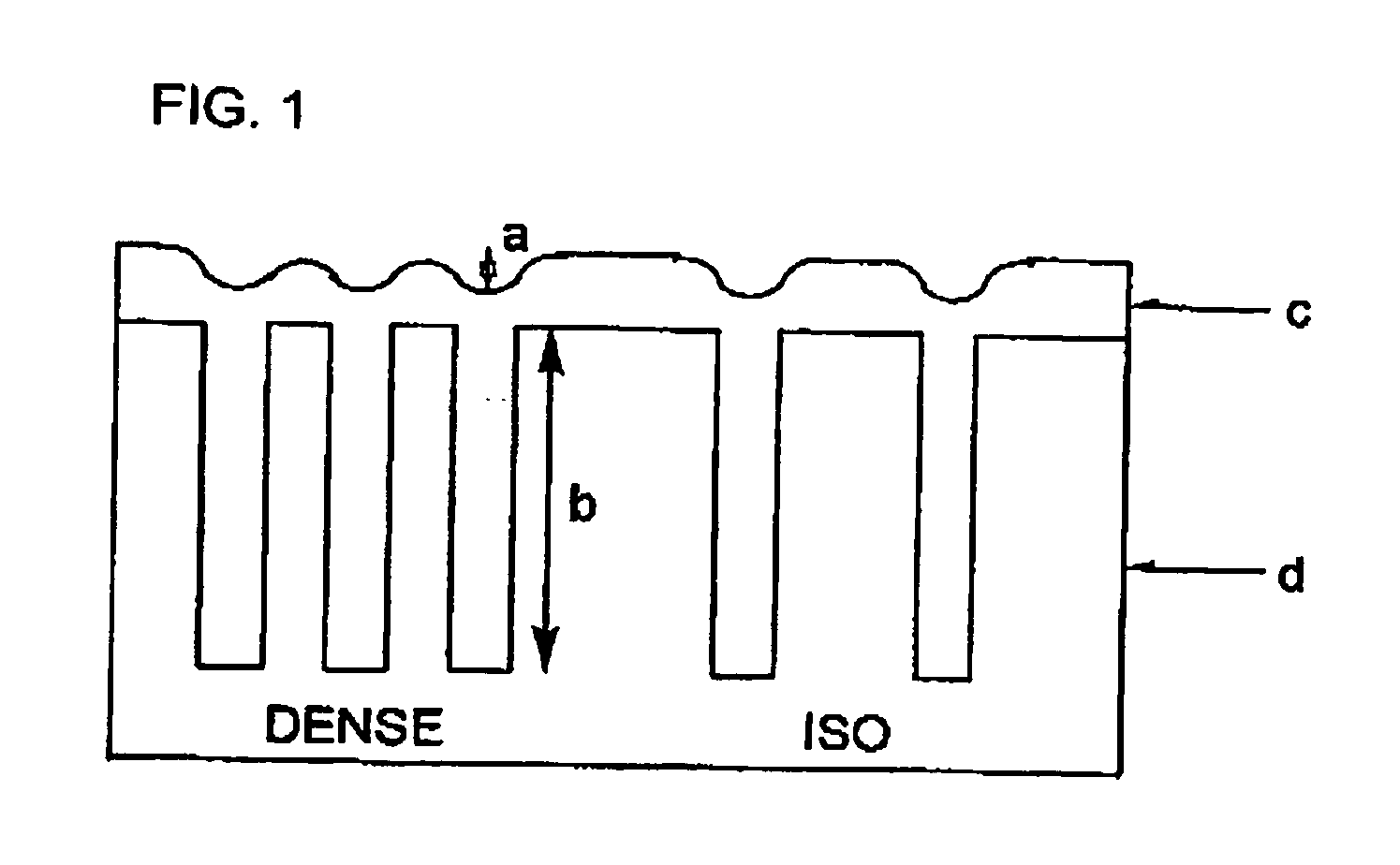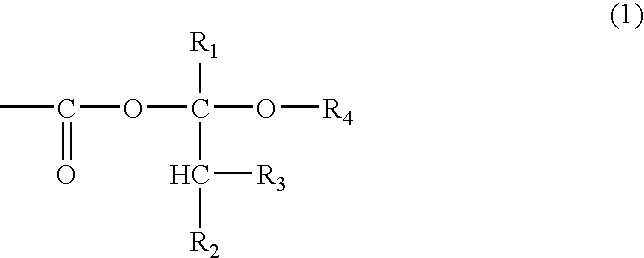Composition for forming lower layer film for lithography comprising compound having protected carboxyl group
a carboxyl group and compound technology, applied in the direction of auxillary/base layers of photosensitive materials, instruments, photosensitive materials, etc., can solve the problems of difficult application of organic materials for anti-reflective coating on a substrate having a high aspect ratio, serious influence of random reflection and standing wave of a substrate, etc., to avoid contamination of semiconductor substrates or clean-room, reduce the production of sublimation substances, and excellent shelf stability
- Summary
- Abstract
- Description
- Claims
- Application Information
AI Technical Summary
Benefits of technology
Problems solved by technology
Method used
Image
Examples
synthetic example 1
[0151]
[0152] In 76 g of propylene glycol monomethyl ether acetate, 10 g of 1-ethoxyethyl methacrylate (product of Honshu Chemical Industry Co., Ltd.) of formula (57) and 9 g of glycidyl methacrylate were dissolved, nitrogen was flowed to the reaction solution for 30 minutes, and then the temperature was raised to 70° C. While maintaining the reaction solution at 70° C., 0.38 g of azobisisobutnitrile and 0.38 g of 1-dodecane thiol were added. After stirring under nitrogen atmosphere at 70° C. for 8 hours, 0.1 g of 4-methoxyphenol was added to obtain a solution containing a copolymer of 1-ethoxyethyl methacrylate and glycidyl methacrylate. GPC analysis of the resulting polymer showed that it had a number average molecular weight Mn of 7600 and a weight average molecular weight Mw of 23000 (in terms of standard polystyrene).
synthetic example 2
[0153] In 126.6 g of propylene glycol monomethyl ether acetate, 10 g of 1-ethoxyethyl methacrylate (product of Honshu Chemical Industry Co., Ltd.) of formula (57), 9 g of glycidyl methacrylate and 12.7 g of methylmethacrylate were dissolved, nitrogen was flowed to the reaction solution for 30 minutes, and then the temperature was raised to 70° C. While maintaining the reaction solution at 70° C., 0.63 g of azobisisobutyronitrile and 0.63 g of 1-dodecane thiol were added. After stirring under nitrogen atmosphere at 70° C. for 8 hours, 0.1 g of 4-methoxyphenol was added to obtain a solution containing a copolymer of 1-ethoxyethyl methacrylate, glycidyl methacrylate and methyl methacrylate. GPC analysis of the resulting polymer showed that it had a number average molecular weight Mn of 5500 and a weight average molecular weight Mw of 12000 (in terms of standard polystyrene).
synthetic example 3
[0154]
[0155] In 38.0 g of butyl acetate, 15 g of 1-cyclohexyloxyethyl methacrylate (product of Honshu Chemical Industry Co., Ltd.) of formula (58) and 10 g of glycidyl methacrylate were dissolved, nitrogen was flowed to the reaction solution for 30 minutes, and then the temperature was raised to 70° C. While maintaining the reaction solution at 70° C., 0.25 g of azobisisobutyronitrile and 0.25 g of 1-dodecane thiol were added. After stirring under nitrogen atmosphere at 70° C. for 8 hours, 0.1 g of 4-methoxyphenol was added to obtain a solution containing a copolymer of 1-cyclohexyloxyethyl methacrylate and glycidyl methacrylate. GPC analysis of the resulting polymer showed that it had a number average molecular weight Mn of 9000 and a weight average molecular weight Mw of 50000 (in terms of standard polystyrene).
PUM
| Property | Measurement | Unit |
|---|---|---|
| molar ratio | aaaaa | aaaaa |
| molar ratio | aaaaa | aaaaa |
| wavelength | aaaaa | aaaaa |
Abstract
Description
Claims
Application Information
 Login to View More
Login to View More - R&D
- Intellectual Property
- Life Sciences
- Materials
- Tech Scout
- Unparalleled Data Quality
- Higher Quality Content
- 60% Fewer Hallucinations
Browse by: Latest US Patents, China's latest patents, Technical Efficacy Thesaurus, Application Domain, Technology Topic, Popular Technical Reports.
© 2025 PatSnap. All rights reserved.Legal|Privacy policy|Modern Slavery Act Transparency Statement|Sitemap|About US| Contact US: help@patsnap.com



